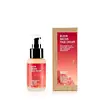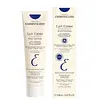What's inside
What's inside
 Key Ingredients
Key Ingredients

 Benefits
Benefits

 Concerns
Concerns

 Ingredients Side-by-side
Ingredients Side-by-side

Aloe Barbadensis Leaf Juice Powder
Skin ConditioningGlycerin
HumectantCoco-Caprylate/Caprate
EmollientPropanediol
SolventPrunus Amygdalus Dulcis Oil
Skin ConditioningWater
Skin ConditioningCetearyl Alcohol
EmollientGlyceryl Stearate
EmollientButyrospermum Parkii Butter
Skin ConditioningPotassium Palmitoyl Hydrolyzed Wheat Protein
CleansingSimmondsia Chinensis Seed Oil
EmollientCaprylic/Capric Triglyceride
MaskingCalanthe Discolor Extract
Skin ConditioningSodium Hyaluronate
HumectantBrassica Oleracea Italica Extract
AstringentHydrolyzed Rhodophyceae Extract
Helianthus Annuus Seed Oil
EmollientVaccinium Vitis-Idaea Fruit Extract
AntioxidantCitrus Grandis Peel Extract
AstringentLavandula Angustifolia Flower/Leaf/Stem Extract
MaskingPrunus Armeniaca Fruit Extract
Skin ConditioningPyrus Malus Fruit Extract
Skin ConditioningCitrus Aurantifolia Peel Extract
CleansingCucumis Melo Fruit Extract
Skin ConditioningMentha Piperita Leaf Extract
Skin ConditioningPrunus Amygdalus Dulcis Bud Extract
Skin ConditioningPrunus Persica Fruit Extract
AbrasiveVanilla Planifolia Fruit Extract
Skin ConditioningAstaxanthin
Skin ConditioningSalvia Sclarea Extract
AntiseborrhoeicSalicornia Herbacea Extract
Skin ConditioningCitrus Aurantium Dulcis Peel Extract
Emulsion StabilisingAgastache Mexicana Flower/Leaf/Stem Extract
Skin ConditioningCarthamus Tinctorius Seed Oil
MaskingGlycine Soja Oil
EmollientGlyceryl Caprylate
EmollientArginine
MaskingLevulinic Acid
PerfumingSclerotium Gum
Emulsion StabilisingLysolecithin
EmulsifyingSilica
AbrasiveSodium Levulinate
Skin ConditioningXanthan Gum
EmulsifyingPullulan
P-Anisic Acid
MaskingSodium Phytate
Beta-Sitosterol
Emulsion StabilisingCalcium Gluconate
HumectantCitric Acid
BufferingPotassium Sorbate
PreservativeGluconolactone
Skin ConditioningSqualene
EmollientTocopherol
AntioxidantSodium Benzoate
MaskingLimonene
PerfumingLinalool
PerfumingAloe Barbadensis Leaf Juice Powder, Glycerin, Coco-Caprylate/Caprate, Propanediol, Prunus Amygdalus Dulcis Oil, Water, Cetearyl Alcohol, Glyceryl Stearate, Butyrospermum Parkii Butter, Potassium Palmitoyl Hydrolyzed Wheat Protein, Simmondsia Chinensis Seed Oil, Caprylic/Capric Triglyceride, Calanthe Discolor Extract, Sodium Hyaluronate, Brassica Oleracea Italica Extract, Hydrolyzed Rhodophyceae Extract, Helianthus Annuus Seed Oil, Vaccinium Vitis-Idaea Fruit Extract, Citrus Grandis Peel Extract, Lavandula Angustifolia Flower/Leaf/Stem Extract, Prunus Armeniaca Fruit Extract, Pyrus Malus Fruit Extract, Citrus Aurantifolia Peel Extract, Cucumis Melo Fruit Extract, Mentha Piperita Leaf Extract, Prunus Amygdalus Dulcis Bud Extract, Prunus Persica Fruit Extract, Vanilla Planifolia Fruit Extract, Astaxanthin, Salvia Sclarea Extract, Salicornia Herbacea Extract, Citrus Aurantium Dulcis Peel Extract, Agastache Mexicana Flower/Leaf/Stem Extract, Carthamus Tinctorius Seed Oil, Glycine Soja Oil, Glyceryl Caprylate, Arginine, Levulinic Acid, Sclerotium Gum, Lysolecithin, Silica, Sodium Levulinate, Xanthan Gum, Pullulan, P-Anisic Acid, Sodium Phytate, Beta-Sitosterol, Calcium Gluconate, Citric Acid, Potassium Sorbate, Gluconolactone, Squalene, Tocopherol, Sodium Benzoate, Limonene, Linalool
Water
Skin ConditioningCaprylic/Capric Triglyceride
MaskingGlycerin
HumectantOctyldodecanol
EmollientPolyglyceryl-3 Methylglucose Distearate
EmulsifyingButyrospermum Parkii Butter
Skin ConditioningCera Alba
EmollientJojoba Esters
EmollientHelianthus Annuus Seed Wax
Skin ConditioningGlyceryl Stearate
EmollientXanthan Gum
Emulsifying1,2-Hexanediol
Skin ConditioningCaprylyl Glycol
EmollientSodium Hydroxide
BufferingAcrylates/C10-30 Alkyl Acrylate Crosspolymer
Emulsion StabilisingPolyglycerin-3
HumectantAcacia Decurrens Flower Wax
EmollientAloe Barbadensis Leaf Juice Powder
Skin ConditioningTocopherol
AntioxidantTropolone
Skin ConditioningGlycine Soja Oil
EmollientHydrolyzed Soy Protein
HumectantWater, Caprylic/Capric Triglyceride, Glycerin, Octyldodecanol, Polyglyceryl-3 Methylglucose Distearate, Butyrospermum Parkii Butter, Cera Alba, Jojoba Esters, Helianthus Annuus Seed Wax, Glyceryl Stearate, Xanthan Gum, 1,2-Hexanediol, Caprylyl Glycol, Sodium Hydroxide, Acrylates/C10-30 Alkyl Acrylate Crosspolymer, Polyglycerin-3, Acacia Decurrens Flower Wax, Aloe Barbadensis Leaf Juice Powder, Tocopherol, Tropolone, Glycine Soja Oil, Hydrolyzed Soy Protein
 Reviews
Reviews

Ingredients Explained
These ingredients are found in both products.
Ingredients higher up in an ingredient list are typically present in a larger amount.
Aloe Barbadensis Leaf Juice Powder comes from the aloe plant.
You may know Aloe to be a good sunburn reliever and inflammation reducer. This is because it contains many components that are known to help reduce irritation and itchiness.
Aloe leaves are also great moisturizers. They are naturally rich in polysaccharides, a carbohydrate made of sugars. Polysaccharides are able to mimic the carbs found in the top layer of your skin. This can help keep your skin hydrated.
Aloe contains the antioxidants Vitamins A, C, and E. These vitamins neutralize free radicals. Free-radicals are molecules that may damage your skin cells, such as pollution.
Aloe does not protect against UV rays, despite it soothing sunburns.
Learn more about Aloe Barbadensis Leaf Juice PowderThis ingredient is also known as shea butter. It is an effective skin hydrator and emollient.
Emollients help soothe and soften your skin. It does this by creating a protective film on your skin. This barrier helps trap moisture and keeps your skin hydrated. Emollients may be effective at treating dry or itchy skin.
Shea butter is rich in antioxidants. Antioxidants help fight free-radicals, or molecules that may harm the body. It is also full of fatty acids including stearic acid and linoleic acid. These acids help replenish the skin and keep skin moisturized.
While Shea Butter has an SPF rating of about 3-4, it is not a sunscreen replacement.
Shea butter may not be fungal acne safe. We recommend speaking with a professional if you have any concerns.
Learn more about Butyrospermum Parkii ButterThis ingredient is an emollient, solvent, and texture enhancer. It is considered a skin-softener by helping the skin prevent moisture loss.
It helps thicken a product's formula and makes it easier to spread by dissolving clumping compounds.
Caprylic Triglyceride is made by combining glycerin with coconut oil, forming a clear liquid.
While there is an assumption Caprylic Triglyceride can clog pores due to it being derived from coconut oil, there is no research supporting this.
Learn more about Caprylic/Capric TriglycerideGlycerin is already naturally found in your skin. It helps moisturize and protect your skin.
A study from 2016 found glycerin to be more effective as a humectant than AHAs and hyaluronic acid.
As a humectant, it helps the skin stay hydrated by pulling moisture to your skin. The low molecular weight of glycerin allows it to pull moisture into the deeper layers of your skin.
Hydrated skin improves your skin barrier; Your skin barrier helps protect against irritants and bacteria.
Glycerin has also been found to have antimicrobial and antiviral properties. Due to these properties, glycerin is often used in wound and burn treatments.
In cosmetics, glycerin is usually derived from plants such as soybean or palm. However, it can also be sourced from animals, such as tallow or animal fat.
This ingredient is organic, colorless, odorless, and non-toxic.
Glycerin is the name for this ingredient in American English. British English uses Glycerol/Glycerine.
Learn more about GlycerinGlyceryl Stearate is a mix of glycerin and stearic acid.
It is used to stabilize the mixing of water and oil ingredients. By preventing these ingredients from separating, it can help elongate shelf life. It can also help thicken the product's texture.
As an emollient, it helps soften skin and supports barrier-replenishing ingredients.
In cosmetics, Glyceryl Stearate is often made from vegetable oils or synthetically produced.
This ingredient may not be fungal-acne safe
Fun fact: The human body also creates Glyceryl Stearate naturally.
Learn more about Glyceryl StearateGlycine Soja Oil comes from the soybean. Glycine Soja is native to eastern Asia.
Soybean oil is an emollient. It is rich in antioxidants and fatty acids including palmitic, stearic, oleic, and linoleic acids.
As an emollient, the fatty acids in soybean oil helps keep your skin soft and hydrated. It does so by creating a film on top that traps moisture in.
Soybean oil is also rich in vitamin E, a potent antioxidant. Vitamin E is also anti-inflammatory and provides a soothing effect.
Studies show soy may help fade hyperpigmentation from UVB. It does so by disrupting the melanin process from UVB induced skin inflammation.
This ingredient may not be malassezia folliculitis, or fungal-acne, safe.
Soybeans are rich in proteins and are part of the legume family. Foods made with soybeans include tofu, soymilk, edamame, miso, and soy sauce.
Learn more about Glycine Soja OilTocopherol (also known as Vitamin E) is a common antioxidant used to help protect the skin from free-radicals and strengthen the skin barrier. It's also fat soluble - this means our skin is great at absorbing it.
Vitamin E also helps keep your natural skin lipids healthy. Your lipid skin barrier naturally consists of lipids, ceramides, and fatty acids. Vitamin E offers extra protection for your skin’s lipid barrier, keeping your skin healthy and nourished.
Another benefit is a bit of UV protection. Vitamin E helps reduce the damage caused by UVB rays. (It should not replace your sunscreen). Combining it with Vitamin C can decrease sunburned cells and hyperpigmentation after UV exposure.
You might have noticed Vitamin E + C often paired together. This is because it is great at stabilizing Vitamin C. Using the two together helps increase the effectiveness of both ingredients.
There are often claims that Vitamin E can reduce/prevent scarring, but these claims haven't been confirmed by scientific research.
Learn more about TocopherolWater. It's the most common cosmetic ingredient of all. You'll usually see it at the top of ingredient lists, meaning that it makes up the largest part of the product.
So why is it so popular? Water most often acts as a solvent - this means that it helps dissolve other ingredients into the formulation.
You'll also recognize water as that liquid we all need to stay alive. If you see this, drink a glass of water. Stay hydrated!
Learn more about WaterXanthan gum is used as a stabilizer and thickener within cosmetic products. It helps give products a sticky, thick feeling - preventing them from being too runny.
On the technical side of things, xanthan gum is a polysaccharide - a combination consisting of multiple sugar molecules bonded together.
Xanthan gum is a pretty common and great ingredient. It is a natural, non-toxic, non-irritating ingredient that is also commonly used in food products.
Learn more about Xanthan Gum